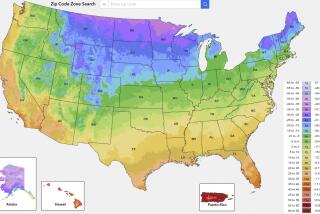Updated Index Promises Warming Trend
- Share via
WASHINGTON — It may not seem quite so cold this winter.
The windchill index, a weather forecaster’s favorite tool for measuring how bitterly cold it feels, has been updated to produce fewer subzero readings, the government said Thursday.
The National Oceanic and Atmospheric Administration rolled out a new windchill index that still depends on wind speed and temperature but includes other, more precise measurements.
The new index was formulated to produce a more accurate measurement than the old method, which was based on science from Antarctic explorers in the 1940s.
Under the new formula, a 10-mph wind makes a reading of 30 degrees Fahrenheit feel like 21 degrees and a reading of 15 degrees feel like 3 degrees. The old formula calculated that with a 10-mph wind 30 degrees felt like 16 and 15 degrees felt like minus 3.
A 20-mph wind under the new formula makes a 30-degree reading feel like 17 and 15 degrees feel like minus 2. The old formula showed a 20-mph wind making 30 degrees feel like 4 and 15 feel like minus 17.
Besides changing some estimated temperature readings, the new index adds a calculation of how long it will take exposed skin to develop frostbite.
The chart shows frostbite occurring in 30 minutes at minus 10 degrees and a 5-mph wind. At the same temperature, a 30-mph wind brings on frostbite in 10 minutes.
The new index uses wind speed calculated at an average height of 5 feet and is based on a human face model.
It also incorporates modern heat transfer theory, in which heat is lost from the body to its surroundings during cold and windy days.
NOAA published a calculator on its Web site, https://www.nws.noaa.gov/om/windchill, to determine windchill and risk of frostbite.
More to Read
Sign up for Essential California
The most important California stories and recommendations in your inbox every morning.
You may occasionally receive promotional content from the Los Angeles Times.








